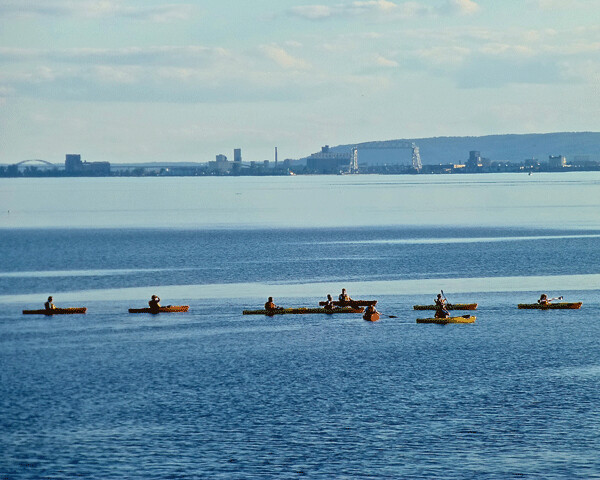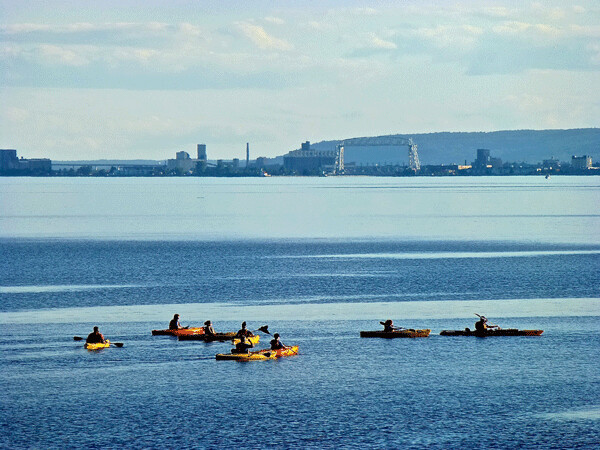Clean water, clean air combine for great recreation

The greatest thing about living in Northern Minnesota is that we enjoy our spectator sports, and we have them live and on the flat screen, but we also can entertain ourselves by doing an unlimited number of active sports on our own.
The other day, I was driving in from the North Shore and just as I was circling down to get to Lester River, I saw what I thought was an armada of kayaks. Actually, I guess it was an armada of kayaks.
It turned out to be a regular group that makes recreational runs up the North Shore and back, so apparently they weren’t competing, as far as I know, they were just having a good time and getting a very thorough workout at the same time.
The thought ran through my mind that Lake Superior is our own private treasure trove. You can fish in it, take a pleasure boat cruise on it, you can pole your way around on a paddle board, you could go canoeing, or you can organize a group and take regular kayak trips along the shoreline as far as your body will let you paddle. And back.
You also, of course, can take a long drive up the North Shore and get your enjoyment out of the scenic wonders of gazing out across the wild blue yonder of the big lake’s surface.
All of that occurred to me while watching those kayak folks do their thing. Of course, it helps to have it be the kind of beautiful day we’ve been enjoying lately, with temperatures in the 70s and a lot of sunshine and fleecy clouds. If it’s chilly and windy, you might want to do something different than be out in a canoe or kayak on rough waters.
It also occurred to me the wonders that have happened to Lake Superior in our lifetime. Older folks can remember the horrible situation of Reserve Mining, when concentric rings formed out from the then-new town of Silver Bay, spreading foam and slime out into Lake Superior all the while the mining company insisted that that toxic sludge was not dangerous and that it would dissipate in the lake. Not to worry.
Fortunately, enough people in high places worried enough to force the cleanup of the horrible pollution that ruined our enjoyment and use of the lake, and now we’re pretty much back to normal.
Of course, we’re never free of the concerns, because they still tell us we can only eat walleyes caught where the St. Louis River runs into the Duluth Harbor a couple of times a week because of the toxic buildup. The money is finally there, and we’re going to set out to clean up that area, also.
Still, everybody must remain vigilant to guard and protect our clean water and clean air, and that goes for up the hill from the lake to Ely and the Boundary Waters Canoe Area, where we continue to have this peculiar battle between factions that are strictly separated between those who are so staunchly in favor of mining that they believe all mining is good and anyone who might try to restrict it is a hateful foe, and those who are so strongly behind keeping the BWCA clean and preventing sulfide mining near it that they can be painted as being opposed to mining of any kind, which is clearly untrue.

From my research, the problem is that iron ore, and taconite mining did some damage to the environment, but it wasn’t horrible. The current debate is trying to paint copper-nickel mining as being as harmless as taconite, when it is entirely different; sulfide mining doesn’t just leave piles of taconite and iron waste, it leaves highly toxic stuff that doesn’t ever go away or purify itself with enough rainstorms.
In fact, the toxic waste ponds loaded with sulfide waste means that if a flock of ducks lands in that pond, and then flies to another lake, that lake also will be polluted. And this stuff is highly toxic. It’s bad enough that some people who are 100 percent behind the iron mining industry draw the line at supporting sulfide mining for a couple of significant reasons. First, there has never been a sulfide mine anywhere on earth that did not leak toxic stuff to surrounding lakes and rivers and woods. Second, Polymet, a Canadian company that wants to take over and convert taconite mines to sulfide mining near the Kawishiwi River, has never operated a mine. Never. And yet it insists it knows of new technology that will negate any pollution.
Farther north, right adjacent to the Boundary Waters, Twin Metals is operating as an arm of a Chilean company known best for destroying natural environment wherever it has operated, and it wants to do exploratory mining tests to evaluate the precious metals of Northern Minnesota. Governor Mark Dayton and the state of Minnesota has blocked that research, although other factions are fighting vehemently to allow permits for such exploration.
Calmer and more objective heads figure the reward might be great, but the risk is far greater. Too great. If the BWCA area gets touched by sulfide pollution, it may take 500 years to clean it up. Maybe longer. Like, forever.
Personally, I am all for the environment and keeping the BWCA area pure and clean so that it can continue to attract hundreds of thousands of tourists and campers and outdoors people every year. I also am all for good mining jobs. But I would feel better about this whole escapade if U.S. companies were the ones doing the exploration. Why, I ask myself, are so many people so anxious to fight vehemently to allow questionable foreign companies to come into Northern Minnesota and take the precious metals out of the U.S. to enrich themselves. True, they will hire a few people from here to operate the mines, but the number who will benefit are practically nothing when compared to the hundreds or thousands of jobs in restaurants, motels, outfitters, resorts and all the businesses that benefit from tourism in Northeastern Minnesota.
I continue to be impressed by such groups as Save Lake Superior, and the governmental Great Lakes Commission, and I’ve attended some of their meetings, although I don’t belong to any of those political groups. I encourage anyone and everyone to attend any such meetings to learn about the work being done to assure that our kids, and grandkids, will have the same clean air and clean water we’ve enjoyed, whether casting from shore at a North Shore stream, driving up the North Shore, or heading up to Ely and the BWCA to get outfitted for a canoe or camping trip into the wilderness.
It is important to get involved, and if you can’t find the time to do that, at the very least you can — and must — stay vigilant.
All-Star Appeal
When I was growing up, the Major League All-State baseball game was one of the highlights of every summer. I loved the days when your favorite players from the two leagues would get selected and play against the best from the other league. In those days, the starting eight defensive players might play most or even all nine innings, and a pitcher who was doing well might get to pitch his full allotment of three innings.
The game has changed. With expansion more than doubling the number of teams, and the league dictating that every team must have at least one representative, the game has now evolved to a bizarre exposition in which both managers try desperately to get every player on the roster into the game. So you have pinch-hitters after two innings, pitching changes virtually every inning, and players you’ve never heard of replace established stars who were voted to starting positions.
I guess it’s a good thing that we get to see so many players, but it’s not like it was. And the outcome of the game doesn’t really matter any more. The only remaining asset that sets the baseball All-Star game ahead of hockey, basketball and football is that you still have a pitcher trying to strike out a batter, and fielders trying as hard to make great plays as the hitters are trying to hit a line drive.
The game is next week in Miami, and Twins fans can cheer for Miguel Sano and Ervin Santana representing the American League. Sano was a cinch to start at third base until fans recognized that he had dropped into a slump (.235 for the month of June) that even his prodigious home runs can’t hide, so he finished second. That means we can all applaud the fact that all players must get in, so hopefully Sano can get a couple of innings in at third, and get the chance to launch one out of the park.
Also, while cheering for Santana to show his strikeout slider-into-the-dirt for an inning or so, keep an eye out for Pat Neshek in the National League bullpen. Neshek, who has faced injury and surgery and was figured to be done when the Twins released him, is a Park Center native who has resurfaced with his sixth Major League team. It happens to be the Philadelphia Phillies, and the sidearm fireballer has appeared in 35 games on his current comeback at age 36, and he has a stingy 1.39 earned run average.
We can wish Neshek well, as long as he doesn’t throw any goofy off-speed stuff to Sano!
